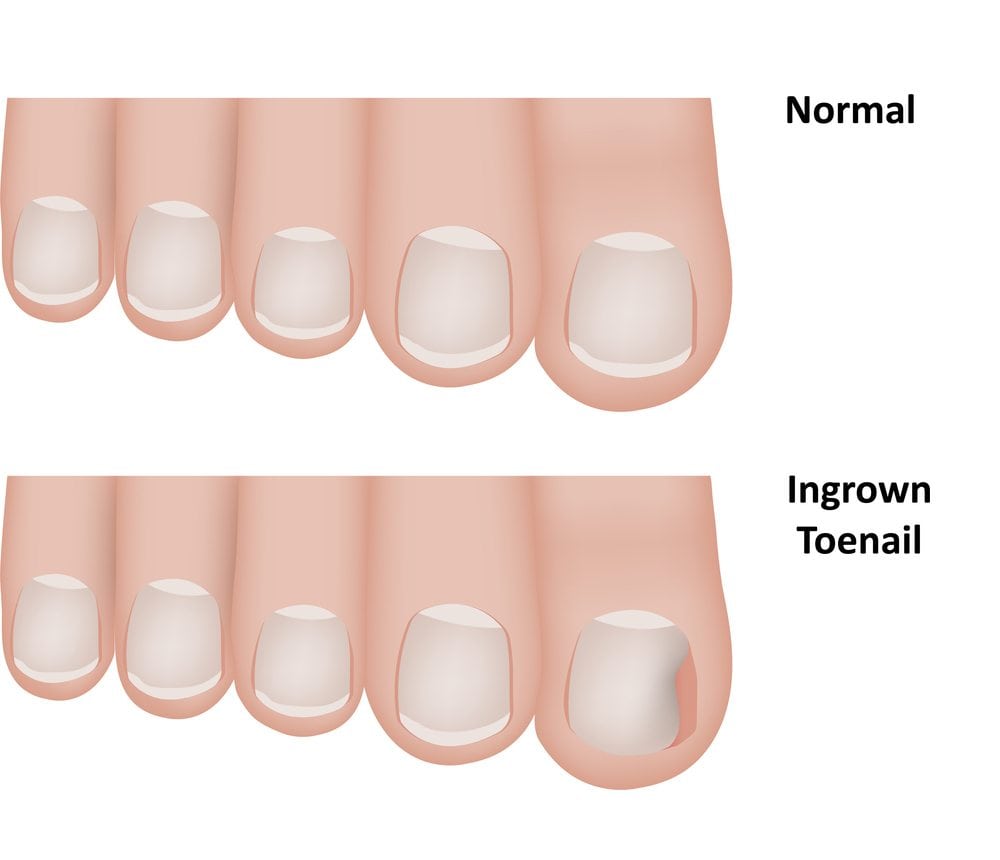Ingrown toenails occur when instead of growing straight, the sides of the nail on the toe curve and grow into the skin on either side of the nail. This causes pain and irritation, as well as possible infection. Ingrown toenails are usually genetic but affect a large portion of the population. An ingrown toenail alone does not necessarily cause pain or issues. An infected ingrown toenail (which is what most people think of when they think of an ingrown toenail) is a condition that needs immediate treatment to prevent a larger infection. We’ve dealt with quite a bit of that here at Hadfield Foot and Ankle.
Did You Know?
Repeatedly trimming the nail down, notching the nail, or putting cotton under the nail can actually make ingrown toenails worse. Continued trimming or notching does not do anything to help the nail’s alignment, and placing cotton under the nail only promotes bacterial growth which can easily lead to an infection.
Frequently Asked Questions
Do I have an ingrown toenail?
If you notice your toenail curving on the edges and growing into your skin, then you probably have an ingrown toenail. You may also experience swelling, redness, and warmth around the affected area. In some cases where the nail breaks the skin, bacteria can enter and cause an infection.
Do kids get ingrown toenails?
It is very common for children to get ingrown toenails and in most cases they can be removed in the office setting. Dr. Hadfield loves treating kids and is nearly always able treat them successfully with minimal pain in the office. Occasionally very young children and those that are afraid of needles may need sedation in order to perform the procedure. Dr. Hadfield will review these options with you.
Does having Diabetes increase chances of an ingrown toenail?
No. But an infected ingrown toenail increases your risk for severe problems, including a bone infection that can lead to amputation. If you have diabetes, nerve damage in the foot, or poor circulation, it is recommended to seek medical attention as soon as possible.
How do I know if I need ingrown toenail treatment?
Ingrown toenails that become swollen, painful and/or red need quick attention to prevent them from worsening. These are signs of an infection and should be seen by a specialist promptly. Dr. Hadfield is well trained and experienced in treating all types of ingrown toenails and would be happy to evaluate yours today.
How will my doctor treat my ingrown toenail?
Treatments vary depending on the severity of the condition. For a mild ingrown toenail, a small portion of the nail may be able to be removed without the need for numbing injections and relief is almost immediate. Standard treatment for a severely ingrown toenail involves removing the portion of the toenail that has grown into the skin. Your toe will first be numbed and then the nail will be removed with sterile instruments. The doctor will then dress and bandage the toe, sending you home with topical ointments and instructions for post-treatment care and follow-up. This removal of the nail can be temporary or permanent depending on the severity of the infection. Dr. Hadfield will review your options with you prior to performing any of these procedures.
What should I expect after treatment?
After treatment, you may be given an oral antibiotic. Your toe will have a small bandage and it is important to keep this surgical site clean until it heals. Most patients report little to no pain after undergoing ingrown toenail treatment, however ice or over the counter pain medication can be used if needed. There is little to no downtime associated with ingrown toenail treatment and you can return to your usual activities the day after treatment.
Is there anything I can do to prevent ingrown toenails in the future?
Yes. When trimming your toenails, cut them straight across instead of rounding them. You should also check your shoes to ensure there is plenty of room for your toes. Cramped toe space raises your risk of ingrown toenails. In many cases ingrown toenails are genetic and even the best prevention techniques cannot totally prevent an ingrown toenail from becoming painful and/or infected.
Dr. Hadfield of Hadfield Foot & Ankle has been serving McKinney and the surrounding Collin County area by providing excellent care to patients through highly skilled conservative and surgical treatments, as well as superior customer service. If you have foot or ankle concerns, schedule a consultation with Dr. Hadfield today and take your next step forward!

